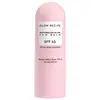What's inside
What's inside
 Key Ingredients
Key Ingredients

 Benefits
Benefits

 Concerns
Concerns

 Ingredients Side-by-side
Ingredients Side-by-side

Butyl Methoxydibenzoylmethane 3%
UV AbsorberHomosalate 8%
Skin ConditioningEthylhexyl Salicylate 5%
UV AbsorberOctocrylene 2.6%
UV AbsorberWater
Skin ConditioningCaprylyl Methicone
Skin ConditioningDipropylene Glycol
HumectantButyloctyl Salicylate
Skin ConditioningDextrin Palmitate
EmulsifyingUndecane
EmollientHydrolyzed Wheat Protein/Pvp Crosspolymer
Tridecane
PerfumingCaprylyl Glycol
EmollientPhenoxyethanol
PreservativeRosa Canina Fruit Oil
EmollientAmmonium Acryloyldimethyltaurate/Vp Copolymer
Carbomer
Emulsion StabilisingCamellia Japonica Seed Oil
EmollientDibutyl Lauroyl Glutamide
Skin ConditioningDibutyl Ethylhexanoyl Glutamide
Skin ConditioningAminomethyl Propanol
BufferingGlycerin
HumectantDipotassium Glycyrrhizate
HumectantTocopheryl Acetate
AntioxidantDisodium EDTA
Mica
Cosmetic ColorantButylene Glycol
HumectantPentylene Glycol
Skin ConditioningHydroxyphenyl Propamidobenzoic Acid
Skin ConditioningIron Oxides
Oxalis Triangularis Extract
Skin ConditioningCI 77891
Cosmetic ColorantCucumis Melo Fruit Extract
Skin Conditioning1,2-Hexanediol
Skin ConditioningTin Oxide
AbrasiveTocopherol
AntioxidantHelianthus Annuus Seed Oil
EmollientButyl Methoxydibenzoylmethane 3%, Homosalate 8%, Ethylhexyl Salicylate 5%, Octocrylene 2.6%, Water, Caprylyl Methicone, Dipropylene Glycol, Butyloctyl Salicylate, Dextrin Palmitate, Undecane, Hydrolyzed Wheat Protein/Pvp Crosspolymer, Tridecane, Caprylyl Glycol, Phenoxyethanol, Rosa Canina Fruit Oil, Ammonium Acryloyldimethyltaurate/Vp Copolymer, Carbomer, Camellia Japonica Seed Oil, Dibutyl Lauroyl Glutamide, Dibutyl Ethylhexanoyl Glutamide, Aminomethyl Propanol, Glycerin, Dipotassium Glycyrrhizate, Tocopheryl Acetate, Disodium EDTA, Mica, Butylene Glycol, Pentylene Glycol, Hydroxyphenyl Propamidobenzoic Acid, Iron Oxides, Oxalis Triangularis Extract, CI 77891, Cucumis Melo Fruit Extract, 1,2-Hexanediol, Tin Oxide, Tocopherol, Helianthus Annuus Seed Oil
Butyl Methoxydibenzoylmethane 3%
UV AbsorberHomosalate 5%
Skin ConditioningEthylhexyl Salicylate 5%
UV AbsorberNeopentyl Glycol Dicaprylate/Dicaprate
EmollientOctyldodecanol
EmollientC15-19 Alkane
SolventCoco-Caprylate/Caprate
EmollientSilica Silylate
EmollientButyloctyl Salicylate
Skin ConditioningPolyester-8
Skin ConditioningDibutyl Lauroyl Glutamide
Skin ConditioningSqualane
EmollientCapryloyl Glycerin/Sebacic Acid Copolymer
Skin ConditioningDibutyl Ethylhexanoyl Glutamide
Skin ConditioningVp/Eicosene Copolymer
Tocopheryl Acetate
AntioxidantCitrullus Lanatus Seed Oil
EmollientParfum
MaskingPentaerythrityl Tetra-Di-T-Butyl Hydroxyhydrocinnamate
AntioxidantTetrahexyldecyl Ascorbate
AntioxidantCaprylic/Capric Triglyceride
MaskingLimnanthes Alba Seed Oil
Skin ConditioningGlyceryl Behenate
EmollientSodium Hyaluronate
HumectantNiacinamide
SmoothingCrithmum Maritimum Extract
Skin ConditioningButyl Methoxydibenzoylmethane 3%, Homosalate 5%, Ethylhexyl Salicylate 5%, Neopentyl Glycol Dicaprylate/Dicaprate, Octyldodecanol, C15-19 Alkane, Coco-Caprylate/Caprate, Silica Silylate, Butyloctyl Salicylate, Polyester-8, Dibutyl Lauroyl Glutamide, Squalane, Capryloyl Glycerin/Sebacic Acid Copolymer, Dibutyl Ethylhexanoyl Glutamide, Vp/Eicosene Copolymer, Tocopheryl Acetate, Citrullus Lanatus Seed Oil, Parfum, Pentaerythrityl Tetra-Di-T-Butyl Hydroxyhydrocinnamate, Tetrahexyldecyl Ascorbate, Caprylic/Capric Triglyceride, Limnanthes Alba Seed Oil, Glyceryl Behenate, Sodium Hyaluronate, Niacinamide, Crithmum Maritimum Extract
Ingredients Explained
These ingredients are found in both products.
Ingredients higher up in an ingredient list are typically present in a larger amount.
Also known as Avobenzone, this ingredient is a chemical sunscreen filter that provides protection in the UV-A range.
Avobenzone is globally approved and is the most commonly used UV-A filter in the world.
Studies have found that avobenzone becomes ineffective when exposed to UV light (it is not photostable; meaning that it breaks down in sunlight). Because of this, formulations that include avobenzone will usually contain stabilizers such as octocrylene.
However, some modern formulations (looking at you, EU!) are able to stabilize avobenzone by coating the molecules.
Avobenzone does not protect against the UV-B range, so it's important to check that the sunscreen you're using contains other UV filters that do!
The highest concentration of avobenzone permitted is 3% in the US, and 5% in the EU.
Learn more about Butyl MethoxydibenzoylmethaneButyloctyl Salicylate is a chemical UV filter structurally similar to octisalate. It is a photostabilizer, SPF booster, emollient and solvent. This ingredient helps evenly spread out ingredients.
According to a manufacturer, it is suitable for pairing with micro Titanium Dioxide, Zinc Oxide, and pigments.
Photostabilizers help stabilize UV-filters and prevents them from degrading quickly.
Learn more about Butyloctyl SalicylateWe don't have a description for Dibutyl Ethylhexanoyl Glutamide yet.
We don't have a description for Dibutyl Lauroyl Glutamide yet.
Ethylhexyl Salicylate is an organic compound used to block UV rays. It primarily absorbs UVB rays but offers a small amount of UVA protection as well.
Commonly found in sunscreens, Ethylhexyl Salicylate is created from salicylic acid and 2-ethylhexanol. You might know salicylic acid as the effective acne fighter ingredient and BHA.
The ethylhexanol in this ingredient is a fatty alcohol and helps hydrate your skin, similar to oils. It is an emollient, which means it traps moisture into the skin.
According to manufacturers, Ethylhexyl Salicylate absorbs UV wavelength of 295-315 nm, with a peak absorption at 307-310 nm. UVA rays are linked to long term skin damage, such as hyperpigmentation. UVB rays emit more energy and are capable of damaging our DNA. UVB rays cause sunburn.
Learn more about Ethylhexyl SalicylateHomosalate is a chemical sunscreen filter that provides protection in the UV-B range (280nm - 320 nm), with a peak protection at 306 nm. It is internationally approved for use in sunscreens.
Homosalate is not photo-stable, meaning it's strength as a UV filter degrades over time with exposure to the sun. Because of this, it's often used in combination with other chemical sunscreen filters as avobenzone (which protects from the UV-A range). Homosalate also helps act as a solvent for harder-to-dissolve UV filters.
(Part of the reason that sunscreens need to be frequently re-applied is due to the photo instability of many chemical sunscreen filters)
Currently, homosalate is approved in concentrations up to 10% in the EU and 15% in the US. The FDA is currently doing further research on the effects of homosalate, and it is possible that these approved concentrations will change in the future.
Learn more about HomosalateTocopheryl Acetate is AKA Vitamin E. It is an antioxidant and protects your skin from free radicals. Free radicals damage the skin by breaking down collagen.
One study found using Tocopheryl Acetate with Vitamin C decreased the number of sunburned cells.
Tocopheryl Acetate is commonly found in both skincare and dietary supplements.
Learn more about Tocopheryl Acetate